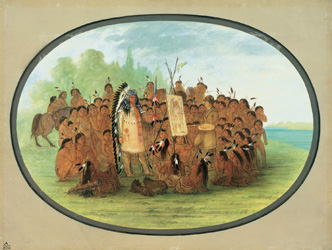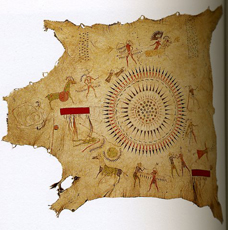ARTH
200 | Assignments |
Glossary
Re-Presentation
Central to contemporary critical theory
is the concept of "re-presentation." The hyphen is very
intentionally added to destabilize our normal reading of the word
"representation" as a reflection of or transparent record
of "reality." No re-presentation can be absolutely objective
or universal. All re-presentations are constructions from particular
subject positions. This is true of all modes of human thought
and expression; it applies equally to the work of the artist,
economist, philosopher, politician, scientist, etc . Critical
theory contends that we only know the world through re-presentations.
Events do occur and physical reality does exist, but we can not
access them or know them independently from re-presentations.
What we take as being "natural"
or "realistic" is thus an effect of re-presentation.
We, for example, understand race as a "natural" way
to read our world, but it is a cultural and not a biological construct.
Race is produced in our language and social practices. Although
we are born either male or female, through cultural re-presentations
we are channeled into different roles and social groups. Whereas
sex is a biological fact, gender is a social construction. Feminine "nature" is thus more
culturally rather than biologically determined. Thus in cultural
re-presentations are produced those images of the world and definitions
of reality which are ideologically mobilized to define and legitimize
the existing order of relations of domination and subordination
between classes, races, and sexes.
Control of re-presentation is thus an
issue of definition of and control of the world. Western domination
of the world is directly tied to its control of methods of re-presentation.
This extends from cartography (look at a globe from a non-western
perspective), to modern scientific thought, to the arts, to, most
recently, CNN and contemporary media (perhaps the Internet will
become an important challenge to this hegemony). Seen in this
framework, debates over what should be considered as "great"
literature and art are not esoteric, ivory-tower debates between
stuffy academics, but central political debates over control of
re-presentation. The conservative critic's strategy of trying
to draw a division between aesthetic and political issues begs
the issue, because who determines aesthetic standards after all?
Remember an African mask becomes "Primitive" and a Greek
statue becomes "Classical" only when they enter western
discourses about art. As John Fiske has written, "Cross-cultural
communication which is initiated and directed by the more powerful
of the two cultures (for power difference is always part of cultural
difference) always runs the risk of reducing the weaker to the
canvas upon which the stronger represents itself and its power
(Power Plays Power Works, p. 149)." Multi-culturalism
should not be simply the study of other cultures, but should be
the attempt to see the world from the perspectives of cultures
other than our own. This is what Cornel West in his lecture entitled
"empathetic imagination." Multi-culturalism thus represents
a powerful tool for self-criticism and reflection.
The power and control of re-presentation
is played out in the frontispiece
to George Catlin's Letters and Notes vol.
1 (London, 1841):

Frontispiece to George Catlin's Letters and Notes on the manners, customs, and conditions of the North American Indians,originally published in 1841.
Catlin provides the following description of his encounter with Mah-T0-Toh-Pa:
No tragedian ever trod the stage, nor gladiator ever entered the Roman Forum, with more grace and manly dignity than did Mah-To-Toh-Pa enter the wigwam, where I was in readiness to receive him. He took his attitude before me, and with the sternness of a Brutus and the stillness of a statue, he stood until the darkness of night broke upon the solitary stillness.
Excerpt of Letter 14.
|

George Catlin, Catlin Painting the Portrait of Mah-To-Toh-Pa , 1857-69, oil on board.
|

The Mandan chief Ma-to-toh-pa also known as Four Bears, by George Catlin, 1832-34. |

Mandan buffalo robe, collected in 1837.
|
Stuart Hall in his book Representation(pp. 25-26) articulates three major theories of representation. The first he identifies as the reflective approach. This assumes that meaning resides in the object, person, idea, or event in the "real" world and that representations reflect these meanings as in a mirror. This was known by the Greeks as mimesis where representations mirror or imitate nature. Hall labels the intentional approach as the second theory. This reverses the first approach and asserts that the writer, artist, etc. imposes his or her unique meanings on the world through representation. But different modes of representation whether they be linguistic or visual are shared codes developed in culture and having their own histories. The third category can be identified as the constructivist or constructionist approach. These theories claim the meaning is constucted in representational systems. This theory draws a clear distinction between the material world where things exist and the symbolic world of modes of representations. It is in the symbolic practices that meaning is constructed.
Kathryn Woodward, Identity and Difference, p. 14: Representation includes the signifying practices and symbolic systems through which meanings are produced and which position us as subjects. Representations produced meanings through which we can make sense of our experience of who we are. We could go further and suggest that these symbolic systems create the possibilities of what we are and what we can become. Representation as a cultural process establishes individual and collective identities and symbolic systems provide possible answers to the questions: who am I?; what could I be? ; who do I want to be? Discourses and systems of representation construct places from which individuals can position themselves and from which they can speak....
Marita Sturken and Lisa Cartwright, Practices
of Looking: an introduction to Visual Culture, p. 12-13: Throughout
history, debates about representation have considered whether
these systems of representation reflect the world as it is, such
that they mirror it back to us as a form of mimesis or
imitation, or whether in fact we construct the world and its meaning
through the systems of representation we deploy. In this social
constructionist approach, we only make meaning of the material
world through specific cultural contexts. This takes place in
part through the language systems (be they writing, speech, or
images) that we use. Hence, the material world only has meaning,
and only can be "seen" by us, through these systems
of representation. This means that the world is not simply reflected
back to us through systems of representation, but that we actually
construct the meaning of the material world through these systems.
Lisa Tickner, Sexuality and/in Representation:
Five British Artists," in Donald Preziosi, The Art of
Art History: A Critical Anthology, p.357: We have no unmediated
access to the real. It is through representations that we know
the world. At the same time we cannot say, in a simple sense,
that a representation or an image "reflects" a reality,
"distorts" a reality, "stands in place" of
an absent reality, or bears no relation to any reality "whatsoever."...
Reality is a matter of representation....,and representation is,
in turn, a matter of discourse.
There is another reason why we cannot
measure representations against a "real" to which they
might be held to refer, and that is because "this real is
itself constituted through the agency of representations.."
What the world "is" for us depends on how it is described.
In an example Victor Burgin gives, we cannot evaluate a particular
representation of femininity against some true or essential feminine
nature because the femininity we adapt to
and embody is itself the product of representation.
Susanne Kappeler, "The Pornography
of Representation," repr. in Women Studies , p. 483:
Forms of representation have their own histories, yet we have
become so accustomed to representations in many media that the
media and their conventions have become naturalized, 'transparent',
apparently giving a key-hole view on make-believe reality, reflections
of reality. Literature and the visual arts are the expert domains
of representation, and they embody the history of the naturalization
of the medium. Their concepts of realism have fostered our commonsense
attitude of dividing representations into form and content, medium
and represented reality. The aim of realism is to obliterate our
awareness of the medium and its conventions and to make us take
what is represented for a reflection of a natural reality. Realism
sees itself as holding up a mirror to life. The mirror, if not
transparent, reflects, and it is above all 'faithful'. The question
should never arise as who is holding the mirror, for whose benefit,
and from what angle; at least it should not arise in terms which
would make this concept of the mirror --and hence of reality--
problematical....
Representations are not just a matter
of mirrors, reflections, key-holes. Somebody is making them, and
somebody is looking at them, through a complex array of means
and conventions. Nor do representations simply exist on canvas,
in books, on photographic paper or on screens: they have a continued
existence in reality as objects of exchange; they have a genesis
in material production. They are more 'real' than the reality
they are said to represent or reflect. All of these factors somehow
straddle the commonsense divide between fiction and fact, fantasy
and reality.
Stanley Aronwitz and Henry A. Giroux,
Postmodern Education: Politics, Culture and Social Criticism,
p. 116: [P]ostmodernism
presents itself as a critique of all forms of representations
and meanings that claim transcendental and transhistorical status.
It rejects universal reason as a foundation for human affairs,
and poses as alternatives forms of knowing that are partial, historical,
and social. In addition, postmodernism points to a world in which
the production of meaning has become as important as the production
of labor in shaping the boundaries of human existence. In this
view, how we are constituted in language is no less important
than how we are constructed as subjects within relations of production.
The political economy of the sign does not displace political
economy; it simply assumes its rightful place as a primary category
for understanding how identities are forged within particular
relations of privilege, oppression, and struggle. Similarly, postmodernism
serves to deterritorialize the map of dominant cultural understanding.
That is, it rejects the European tradition as the exclusive referent
for judging what constitutes historical, cultural, and political
truth. There is no tradition or story that can speak with authority
and certainty for all of humanity. A postmodernism of resistance
argues that traditions should be valued for their attempts to
name the partial, the particular, and the specific; in this view,
traditions demonstrate the importance of constituting history
as a dialogue among a variety of voices as they struggle within
assymetrical relations of power. Traditions are not valued for
their claims to truth or authority, but for the ways in which
they serve to liberate and enlarge human possibilities. Tradition
does not represent an all-embracing view of life: instead, it
serves to place people self-consciously in their histories by
making them aware of the memories constituted in difference, struggle,
and hope. Tradition, in postmodern terms, is a form of counter-memory
that points to the fluid and complex identities that constitute
the social and political construction of public life.
...a postmodernism of resistance challenges the liberal
humanist notion of the unified, rational subject as the bearer
of history, In this view, the subject is not unified, nor can
such a subject's action be guaranteed in metaphysical or transhistorical
terms. Postmodernism views the subject as contradictory and multilayered,
and rejects the notion that individual consciousness and reason
are the most important determinants in shaping human history.
It posits instead a faith in forms of soical transformation that
understand the historical, structural, and ideological limits
that shape the possibility for self-reflection and action. Postmodernism
points to solidarity, community, and compassion as essential aspects
of how we develop and understand the capacities we have for experiencing
the world and ourselves in a meaningful way. More specifically,
postmodernism offers a series of referents for rethinking how
we are constituted as subjects within a rapidly changing set of
political, social, and cultural conditions.
W.J.T. Mitchell, Iconology: Image,
Text, Ideology, p. 38: ...if vision itself is a product of
experience and acculturation --including the experience of making
pictures-- then what we are matching against pictorial representations
is not any sort of naked reality but a world already clothed in
our system of representation.
ARTH
200 | Assignments
| Glossary



